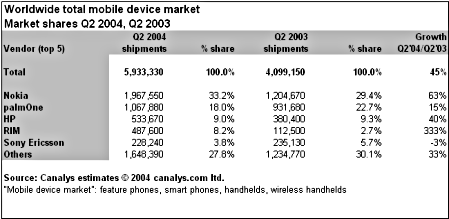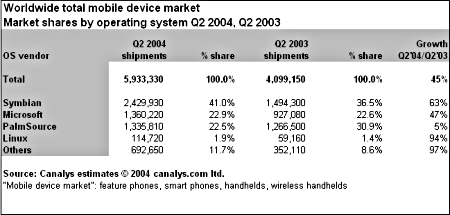Linux small but growing fast in mobile device market
Aug 4, 2004 — by LinuxDevices Staff — from the LinuxDevices Archive — viewsLinux is the fastest growing OS in the mobile device market, but currently accounts for less than 2 percent of total shipments, according to this research report from Canalys. Canalys operates a continuous information service on the mobile device and wireless handset markets, which it says are growing rapidly.
The report also includes a terrific glossary of technical market research terms such as “smartphone,” “feature phone,” “ENEA,” and more.
Smart phones lead by volume, but wireless handhelds growing fastest
Highlights:
- Overall worldwide mobile device market in Q2 2004 up 45 percent on Q2 2003
- Data-centric devices (handhelds/wireless handhelds) up 26 percent
- Voice-centric devices (smart phones/feature phones) up 70 percent
- Nokia is leader overall, and in voice-centric segment
- PalmOne leads in data-centric devices, but share falls, and HP and RIM are growing quickly
Worldwide mobile devices Q2 2004 - highlights from the Canalys research
Canalys, uniquely, covers all the different types of “smart” pocket-sized mobile devices in an integrated worldwide research program. This means that its market share estimates include smart phones like the Sony Ericsson P900, palmOne Treo 600, and Nokia 7610, wireless handhelds such as the RIM BlackBerry range and T-Mobile MDA II, and handhelds without integral wide-area wireless capabilities, like the palmOne Tungsten T3 and HP iPAQ h4150. This provides clients with a complete picture of the market and enables comparison between the different classes of device. The top five mobile device vendors in Q2 2004 were Nokia, palmOne, HP, RIM and Sony Ericsson.

(Click to enlarge)
Nokia dominated the overall mobile device market in Q2 2004, with a 33 percent share by units shipped. It remains the only vendor with a wide range of smart phones. Indeed, Canalys estimates that Nokia was responsible for over 80 percent of all Symbian-based devices shipped in the quarter, and the majority of all smart phones shipped in each of the EMEA, APAC, and Latin America regions. Only in North America, where palmOne's Treo 600 is the leading smart phone, was Nokia pushed into second place.
“Compared to last quarter, Nokia has closed the gap on palmOne in North America,” observed Canalys senior analyst and director Chris Jones. “PalmOne still has supply issues with the Treo 600. If it can solve these, then its numbers will improve, but it also needs a broader selection of devices to appeal to a wider range of customers. It has the advantage of a large, loyal handheld user base, and many will be looking to upgrade to a device that integrates voice and other wide-area wireless functionality, but it needs to offer those users a choice of designs and features. The European-based smart phone vendors have found it difficult to make headway in the North American market so far, but palmOne cannot afford to underestimate the momentum of Symbian.”
Smart phones represented just under 15 percent of palmOne's device shipments in Q2 2004. It remains the clear leader worldwide in the data-centric (handheld and wireless handheld) segment, despite having lost this position in EMEA to HP, and is the number two vendor (18 percent share) overall. Its global market share in the data-centric segment fell seven points in Q2 2004 compared to the same quarter one year ago, despite a slight increase in the number of devices shipped.
Unlike palmOne and Nokia, HP has no voice-centric devices, but managed to hold onto third place in the overall market (9 percent share) thanks partly to continued strong performance in EMEA, which represented almost half of its iPAQ shipments in Q2 2004. Wireless handheld vendor RIM (8 percent share) was narrowly behind HP and enjoyed the highest growth (333 percent) of any of the leading vendors. Growth was strong in North America and EMEA, but its presence in Latin America and APAC remains small. Sony Ericsson, with its P800/P900 series smart phones, was fifth overall (4 percent share), but shipments fell by around 3 percent compared to the year-ago quarter. In voice-centric devices, despite being second, it remains some way behind Nokia.
“Looking at the market by device category reveals some interesting trends,” added analyst Rachel Lashford, “The fastest growing category was wireless handhelds, up 194 percent on Q2 2003. This was largely due to the performance of RIM, but operator-branded Windows Mobile devices, particularly in EMEA, also contributed. North America was the only region where shipments of wireless handhelds exceeded those of smart phones. Shipments of handhelds without integral wide-area wireless capability rose by 10 percent globally, but the growth came from outside North America (which fell 5 percent), with EMEA up 31 percent, Latin America up 66 percent and APAC up 8 percent. Worldwide the smart phone segment grew 112 percent, with all regions posting strong year-on-year figures.”
Global shipments of the four categories of device were as follows: smart phones was the largest segment with 2.9 million units, followed by handhelds at 2.4 million, wireless handhelds at 600,000 and feature phones (a soon-to-disappear category, squeezed between high-end mobile phones and smart phones) around 30,000.

(Click to enlarge)
Looking at the market by operating system, Microsoft led narrowly from PalmSource in the data-centric segment. Symbian dominated the market for voice-centric devices, but PalmSource was ahead of Microsoft in this segment for the first time in over a year. Combining shipments of all mobile devices, Symbian was ahead with 41 percent share, with less than half a percentage point separating Microsoft and PalmSource in second and third respectively.
Terms explained
- Feature phone — pocket-sized device positioned primarily for voice, offers full, configurable two-way data synchronisation, but OS-based applications cannot be added without restriction. Example: Nokia 7650.
- Smart phone — pocket-sized device positioned primarily for voice, offers full, configurable two-way data synchronisation, and OS-based applications can be added without restriction. Example: Sony Ericsson P900.
- Handheld — pocket-sized device positioned primarily for data, no integrated wireless WAN (GSM, GPRS or 3G) capability. Example: palmOne Tungsten T3.
- Wireless handheld — pocket-sized device positioned primarily for data, integrated wireless WAN (GSM, GPRS or 3G) capability. Example: O2 xda II, RIM BlackBerry series.
- Data-centric devices — handhelds & wireless handhelds.
- Voice-centric devices — feature phones & smart phones.
- Mobile device market — handhelds, wireless handhelds, feature phones & smart phones.
- EMEA — Europe, Middle East & Africa.
- APAC — Asia/Pacific region.
About Mobile Device Analysis and Worldwide Mobile Devices
The shipment estimates discussed in this release come from Worldwide Mobile Devices — the global market tracking expansion to Mobile Device Analysis, the leading EMEA-focused continuous advisory service from Canalys.
Copyright © 2004, Canalys. Reproduced with permission by LinuxDevices.com.
This article was originally published on LinuxDevices.com and has been donated to the open source community by QuinStreet Inc. Please visit LinuxToday.com for up-to-date news and articles about Linux and open source.